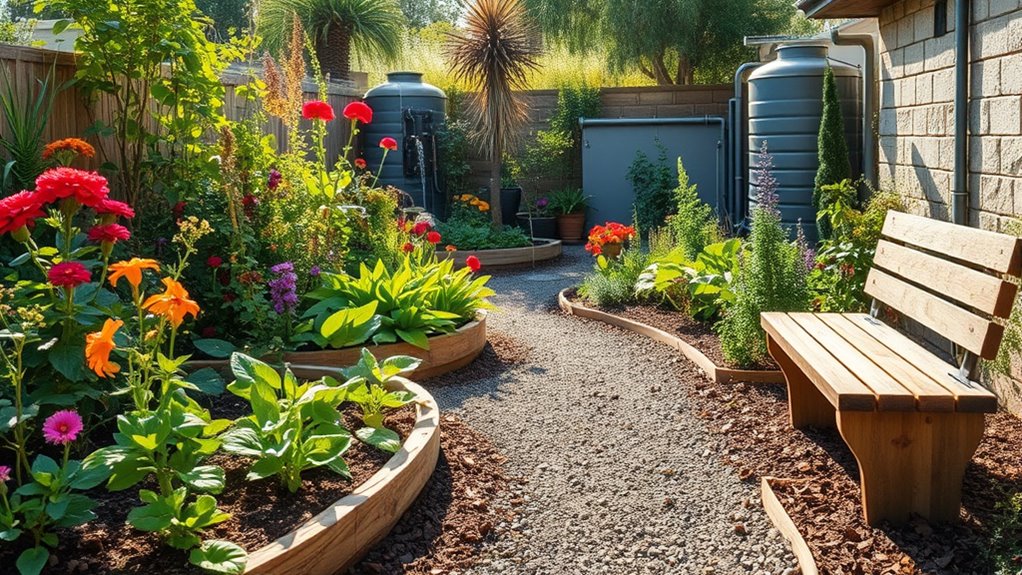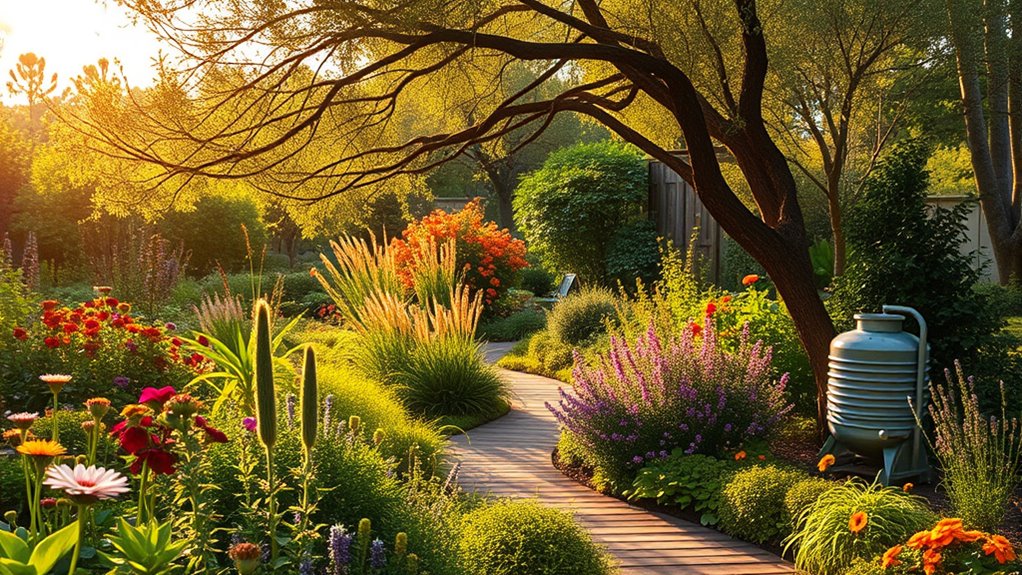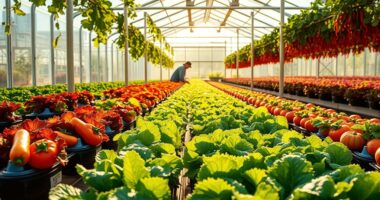To design a sustainable garden that’s both beautiful and eco-friendly, choose native plants that thrive naturally and need less water and upkeep. Incorporate water-saving techniques like drip irrigation, mulch, and rain catchment systems. Use drought-tolerant species and permeable surfaces to reduce runoff and conserve resources. Focus on eco-friendly design strategies that support local wildlife while minimizing your ecological footprint. Keep exploring to discover more ways to create a vibrant, sustainable landscape you’ll love.
Key Takeaways
- Incorporate native plants to create a vibrant, low-maintenance garden that supports local ecosystems.
- Use water-efficient techniques like drip irrigation and rain harvesting to reduce waste while maintaining beauty.
- Select drought-tolerant native species for stunning landscapes that thrive with minimal watering.
- Implement permeable surfaces and natural drainage solutions to enhance aesthetics and promote sustainability.
- Design with eco-friendly materials and mindful planning to balance visual appeal with resource conservation.

Have you ever wondered how to create a garden that’s both beautiful and eco-friendly? Achieving this balance is easier than you might think, especially when you focus on native plants and water conservation. Native plants are the backbone of sustainable garden design because they thrive naturally in your local environment. They require less water, fewer fertilizers, and minimal maintenance, making your garden more resilient and eco-conscious. By selecting native species, you guarantee that your garden supports local wildlife, from pollinators like bees and butterflies to birds and beneficial insects. These plants are adapted to your area’s climate and soil conditions, so they grow vigorously without the need for chemical interventions or excessive watering.
Water conservation is a vital aspect of sustainable gardening. In many regions, water scarcity has become a serious concern, and your garden can play a role in addressing this issue. Incorporate techniques such as drip irrigation, soaker hoses, and mulching to reduce evaporation and guarantee water reaches the roots efficiently. Mulching not only conserves water but also helps suppress weeds and maintain consistent soil temperature. Additionally, consider installing rain barrels or other catchment systems to harvest rainfall, reducing your reliance on municipal water supplies. These methods allow you to water your garden thoughtfully and reduce waste, all while maintaining lush, healthy plants.
Designing with water conservation in mind also means selecting plants that are drought-tolerant once established. Many native plants fall into this category, which means you can create a vibrant, diverse landscape that doesn’t demand constant watering. Grouping plants with similar water needs allows for more targeted irrigation, so you use water only where necessary. Incorporating advanced automation such as smart irrigation controllers can further optimize water use by adjusting watering schedules based on weather conditions. Incorporate permeable surfaces like gravel or mulch pathways to facilitate natural drainage and reduce runoff. This approach helps prevent erosion and filters rainwater into the soil, replenishing underground reserves.
Frequently Asked Questions
How Can I Attract Pollinators to My Sustainable Garden?
To attract pollinators to your sustainable garden, you should create pollinator habitats by providing diverse plants and shelter. Focus on native plant selection, as local species attract more bees, butterflies, and hummingbirds. Avoid pesticides and plant a variety of flowering plants that bloom at different times. This approach makes certain a steady food source, encouraging pollinators to visit regularly, helping your garden thrive while supporting local ecosystems.
What Native Plants Are Best for My Climate Zone?
When choosing native plants, focus on climate zone adaptation to guarantee they thrive. You should research your specific climate zone and select native plant species known for their resilience in that area. This native plant selection not only supports local ecosystems but also reduces water and maintenance needs. By matching plants to your climate zone, you create a sustainable garden that’s both beautiful and eco-friendly, attracting pollinators naturally.
How Do I Compost Effectively in a Small Space?
Did you know that small-space composting can divert up to 30% of your household waste? To compost effectively, place your compost bin in a shady, well-drained spot to prevent odors and pests. Mix organic waste regularly, balancing greens and browns, to speed decomposition. Keep the bin moist and aerated. This simple setup maximizes organic waste diversion, turning kitchen scraps into nutrient-rich compost, even in limited space.
What Eco-Friendly Pest Control Methods Are Safe for Gardens?
You want eco-friendly pest control methods that are safe for your garden. Try using organic pesticides, which are less harmful to beneficial insects and the environment. Attract beneficial insects like ladybugs and lacewings to naturally reduce pests. You can also encourage biodiversity by planting diverse species, creating a balanced ecosystem. Avoid chemical pesticides to protect your garden’s health and promote sustainability. These methods keep your garden safe, vibrant, and eco-friendly.
How Can I Incorporate Rainwater Harvesting Into My Garden Design?
Like a sponge soaking up every drop, you can incorporate rainwater harvesting into your garden by installing a rain barrel or a more extensive collection system. Use water conservation techniques such as directing downspouts into storage containers, then utilize this water for your plants. This not only reduces your reliance on tap water but also helps create a sustainable garden that respects natural resources and minimizes environmental impact.
Conclusion
By designing a sustainable garden, you not only boost your outdoor space’s beauty but also help the environment. Did you know that incorporating native plants can reduce water use by up to 50%? So, every choice you make—like choosing drought-tolerant plants or composting—has a real impact. Embrace eco-friendly practices, and you’ll enjoy a lush, vibrant garden that’s good for the planet and your peace of mind. Your green thumb can truly make a difference!









